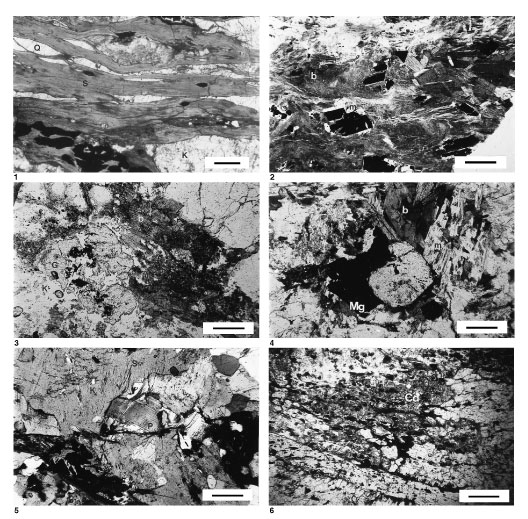
Plate 3. Selected key textural relationships in the pelitic and migmatite gneiss. 1. Foliation defined by intensely oriented harmonious fibrolite (S) with augen of magnetite (black) and aggregates of quartz (Q) and K-feldspar (K). Sample 161-976B-95R-2, 24-28 cm. Plane-polarized light. Scale bar is 500 Ám. 2. Idiomorphic magnetite crystals (black) surrounded by muscovite (m) and decussate aggregates of biotite (b). Sample 161-976B-98R-1, 38-40 cm. Plane-polarized light. Scale bar is 200 Ám. 3. Relic garnet porphyroblast (garnet I) largely corroded by biotite (b) and K-feldspar (K). Sample 161-976B-98R-1, 38-40 cm. Plane-polarized light. Scale bar is 200 Ám. 4. Subidiomorphic garnet porphyroblast (garnet II) surrounded by magnetite (Mg) and biotite (b), which is partially transformed to muscovite (m). Sample 161-976B-98R-1, 96-101 cm. Plane-polarized light. Scale bar is 200 Ám. 5. Example of disharmonious fibrolite (S) included in large K-feldspar (K) and plagioclase (P) phenocrysts. Leucosome domain of a migmatitic gneiss. Sample 161-976B-95R-2, 24-28 cm. Cross-polarized light. Scale bar is 200 Ám. 6. Late irregular spongy porphyroblast of cordierite (Cd) including quartz, fibrolite, and ilmenite, which define the main foliation in the rock. Cordierite is largely transformed to pinnite. Large idiomorphic andalusite porphyroblast (A) is oriented parallel to the main foliation. Sample 161-976B-101R-1, 86-89 cm. Plane-polarized light. Scale bar is 500 Ám. Click on image for
enlargement.



![]()